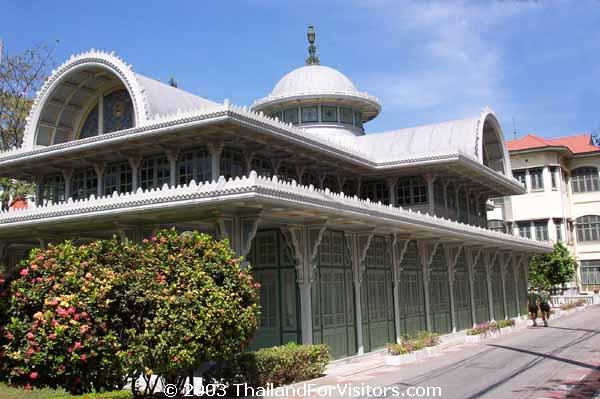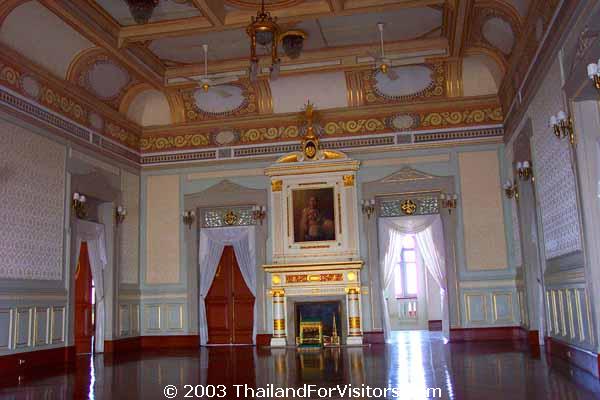It's hard to believe now, but when it was built in 1909, Phayathai Palace was a 'country' cottage where King Rama V (Chulalongkorn) and Queen Saowabha could escape on the weekends and relax 'down on the farm.' The small palace was indeed a farm where the king and queen conducted agricultural experiments - something the current king still practices at Chitlada Palace as well.
The queen apparently enjoyed the palace greatly, and sometimes lingered there for several days, forcing the king to drive his new yellow electric car to visit her. This bucolic idyll didn't last long. King Chulalongkorn died on 23 October 1910, only a few months after the palace's official inauguration.
The queen returned to the Grand Palace for a while, but then came back to Phayathai Palace, where she lived out her days. Queen Saowabha passed away at Phayathai Palace ten years after her husband, in 1919. After her death, King Rama VI pulled down most of the buildings and had a new royal residence built on the site.

The Thewaratsaparom Throne Hall, used as a theater.
The only main building that remains from the original palace is the Thewaratsaparom Throne Hall, a beautiful glass and wood confection of a building that was mostly used as a theater, reception hall and for performing merit-making ceremonies.
The theater is basically one big room with French doors running around the exterior. Although rectangular in plan, the roof is two-tiered with the second tier forming a cruciform of barrel vaults intersecting beneath raised dome. The edge of the roof is lined with finely carved fretwork. The columns supporting the roof and interior balcony sport intricately carved pierced bracket supports.
Rama VI was a keen playwright and actor, so the theater was much in use during his reign.

Throne hall of the central building.
The main palace buildings are actually a group of two to three story buildings linked by open walkways which give the complex the appearance of a single monolithic facade. The central building of the group is the Phiman Chakri Throne Hall. The building features a round turret at one corner, capped by a steep red conical roof.
The ground floor is surrounded by open corridors, with a grand staircase in the rear leading up to the royal apartments on the second floor. The large central room on the second floor was used as a throne hall, although photographs from the time make it appear to be more like a fancy Western styled parlor. The room is also decorated in a very Western style, with a fireplace at the back and elaborate decoration of the corniced ceiling.
The main entry to the Phiman Chakri Throne Hall is covered by a solid roof which extends from the second floor level to a sort of carriage house that has variously been a waiting room, a billiard room, and now serves as a coffee shop.
The room to the west of the throne hall was once the queen's bedchamber and is now used for teaching Thai classical music. The round room in the turret was a study. Now it's something of a shrine to the late queen.
The building to the west of the Phiman Chakri Throne Hall, with its own squarish tower, is the Srisuthiniwat building. It was the reception and residence hall for the female members of the royal family, who at the time were still largely segregated from the male members and servants.

The 'Roman' garden behind the palace buildings.
Behind the palace building was a large garden. In Rama V's time, this was where the experimental farm was located. Rama VI built the 'Roman Garden' immediately behind the residence. Further back he had a model city called 'Dusit Thani' built to help train people how a city should be run.
The model city is gone but a shrine to Thao Hiranphanasoon remains and is quite popular with employees and visitors to the grounds. The shrine is surrounded by ancient banyan trees on one side. On the other side of the shrine is a small modern open sala housing a rather unique Buddha statue. The statue depicts a seated Buddha encased to his shoulders by a five-headed cobra.
When Rama VI passed away in 1925, the palace was for a time turned into a hotel serving foreign dignitaries on state visits as well as businessmen. Then for a time it housed a radio station. After the 1932 revolution which ended the absolute monarchy, like many royal residences the property was confiscated by the army, which turned the old palace into a hospital, now called the Phramongkutklao Hospital (King Mongkut Hospital).
Operating Hours
The palace buildings are mostly open to the public. It may seem a bit strange to visit a hospital as a tourist, but the buildings are mostly used for administrative and public functions, and the staff are generally quite tolerant of people who come just to look at a bit of Thai heritage. Visitors are welcome Monday to Saturday. There is no admission fee.
Note that as of late 2012 the second floor of the main building was closed for renovation.
Getting There
Phayathai Palace is within the grounds of Phramongkutklao Hospital at 315 Rachawithi Road. It's a short distance from the the Victory Monument, making it easily accessible by Skytrain to the Victory Monument station, then walk east down Rachawithi. The palace is on the north side of the road.